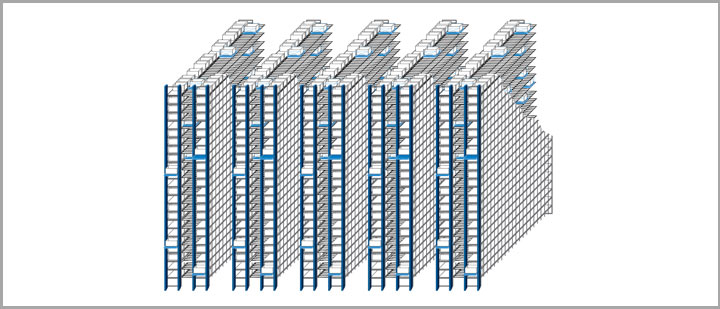Shuttle systems provide a flexible and dynamic way of storing small unit loads. In the course of development, different system types have developed within a few years, which can be characterized, for example, by the movement axes of the shuttle vehicles. Shuttle systems with aisle-bound and tier-bound vehicles enable the highest throughput. However, the maximum achievable throughput is limited by the performance of the lifting systems or the individual shuttle vehicles. Further lift and shuttle vehicles in the shaft or tier could increase throughput - if several vehicles can be coordinated in the same shaft or tier.
The aim of the research project is to increase the throughput of shuttle systems with aisle-bound and tier-bound vehicles by using several vehicles in the same tier and shaft. The result is a shuttle system in which several actors (lift vehicles or shuttle vehicles, hereinafter also referred to as servers) operate in the same movement space - a vertical or horizontal line. As a result, each aisle on each tier and in each lifting system contains a multi-server system. In order to operate such multi-server shuttle systems in a robust and efficient manner, operational strategies must be developed which include rules for the allocation of storage, retrieval and transfer orders to the individual vehicles as well as movement strategies for the execution of the orders. In order to enable an optimal throughput configuration of the systems, a parameterizable simulation tool is designed in which the developed strategies are applied and which allows for the analysis and evaluation of different configurations.
The optimal configuration of multi-server shuttle systems takes place in six work packages (WPs). The first step is to research the current state of the art with regard to current design and control procedures for shuttle and multi-server systems (WP1). Subsequently, relevant characteristics of shuttle systems and their effects on the control strategies are identified (WP2).
The next step is to develop control strategies for the identified system characteristics of multi-server shuttle systems (WP3) on the basis of the already researched control procedures. The creation of a parameterizable simulation model (WP4) allows for the investigation of the selected characteristics of multi-server shuttle systems by integrating the designed control strategies. In parameter studies different combinations of control alternatives, dimensions and boundary conditions are simulatively investigated (WP5).
Based on this, recommendations are derived and can be used as a guideline for the design of multi-server shuttle systems with corresponding boundary conditions (WP6).
- Gebhardt Fördertechnik
- TGW Logistics Group
- psb intralogistics
- Jungheinrich Logistiksysteme
- SSI Schäfer Automation
- Kardex Germany
- PROTEMA Unternehmensberatung
- Weissenborn Logistik-Consulting
- io-consultants
- Miebach Consulting
- F+B Consultants
This research project is carried out on behalf of the Forschungsgemeinschaft Bundesvereinigung Logistik e.V. (German Logistics Research Association) (BVL) and is funded by the Federal Ministry of Economics and Technology through the German Federation of Industrial Research Associations "Otto von Guericke" e.V. (AiF).
